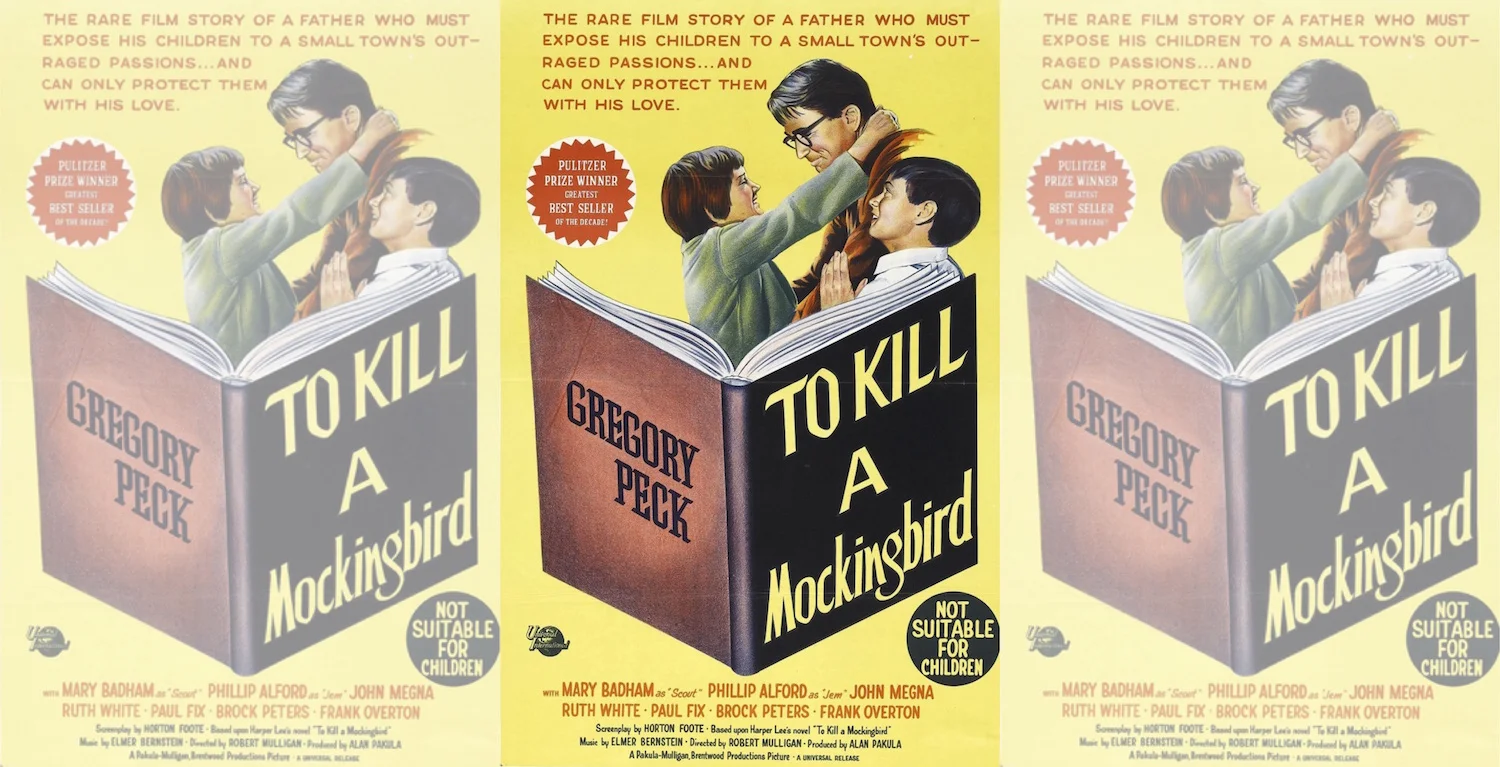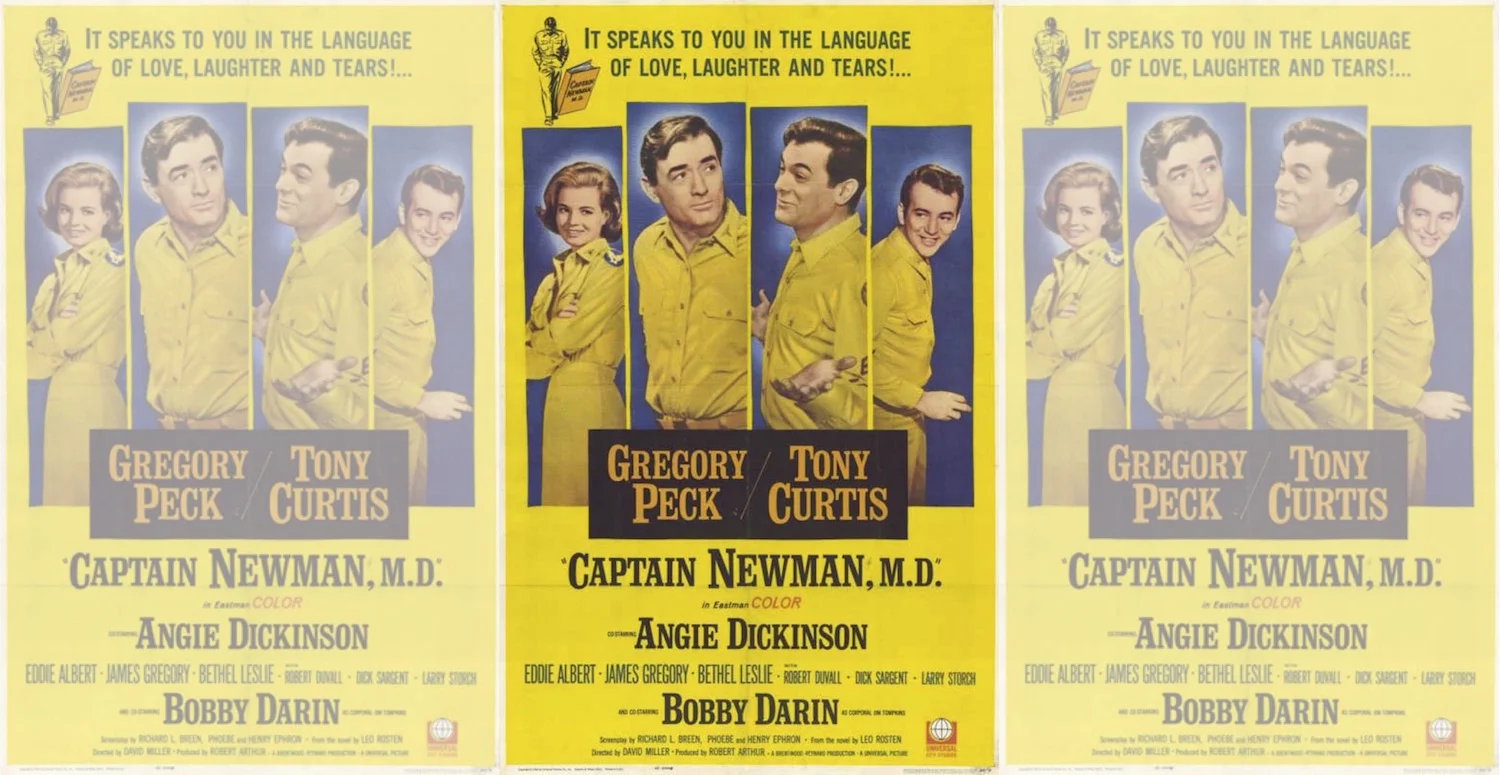To Kill a Mockingbird (1962)
PULITZER PRIZE-WINNING NOVEL YIELDS ACADEMY AWARD-WINNING FILM
In 1960, Harper Lee published To Kill a Mockingbird to tremendous acclaim. A week after its debut, it bounded to the top of the bestseller lists, and it remained there for 88 consecutive weeks. Less than a year after appearing in bookstores, the novel captured the Pulitzer Prize for Fiction. Almost six decades later, To Kill a Mockingbird has long been considered a classic of American literature. But none of those details guaranteed that a film based upon that source material would also succeed.
In the foreground: Gregory Peck and Brock Peters in To Kill a Mockingbird
The cinematic version of To Kill a Mockingbird, released less than three years after the book’s debut, starts first and foremost with its screenplay. Writer Horton Footegrounds his script in Harper Lee’s wonderful novel by employing the same first-person narration of its primary protagonist, Jean Louise Finch, nicknamed Scout (portrayed by Mary Badham). Mr. Foote begins and ends the film with commentary by the adult Finch looking back on her childhood; during the course of the story, Scout ages from six to nine. The screenplay utilizes the device only sparingly, but it works effectively as an introduction, in several transitions, and as a coda. Given voice by an uncredited Kim Stanley, the languid narration serves to lend perspective to the setting of the American South, to pace the film, and to capture some of Ms. Lee’s artistic and insightfully observational prose. Mr. Foote’s script earned him the first of his three Academy Award nominations for writing, and the first of his two Oscars. (He would receive nods for Tender Mercies in 1983 and The Trip to Bountiful in 1985, winning for the former.)
To Kill a Mockingbird takes place in the small Alabama town of Maycomb, during the height of the Great Depression. The story recounts several formative incidents in Scout’s youth. She and her older brother, Jeremy, who everybody calls Jem (Phillip Alford), befriend a boy named Dill (John Megna), who is visiting his aunt (Alice Ghostley) for the summer. Together, the three children play, seek out youthful country adventures, and ruminate on the strange case of Arthur Radley (Robert Duvall). The young man, whom the townsfolk all refer to as Boo, never leaves his house, where he lives with his dour and controlling father. Radley apparently committed mischief as a teen with some other boys, and in order to prevent him from being punished by the town judge, his father (Richard Hale) essentially promised to keep him under informal house arrest. Numerous suspect tales about Boo circulate through Maycomb, including that he sneaks out at night to feast on raw cats and squirrels. Scout, Jem, and Dill grow enamored of the idea of coaxing the young man from his home—not born of any mean-spirited motivation, but out of an earnest curiosity.
At the same time, Scout and Jem watch as their widowered father, Atticus Finch (Gregory Peck), agrees to take on a high-profile criminal case as defense counsel. Under the cruel and controlling influence of her ignorant father (James Anderson), a poor white woman named Mayella Ewell (Collin Wilcox) has accused an equally poor black man, Tom Robinson (Brock Peters), of raping her. Town Judge John Taylor (Paul Fix) solicits the help of Atticus, knowing that, given the prevailing racial sentiments of the time, no other local attorney would defend a person of color.
Gregory Peck as Atticus Finch, delivering his closing statement in To Kill a Mockingbird, with Paul Fix as Judge John Taylor and Brock Peters as defendant Tom Robinson
Gregory Peck as Atticus Finch, delivering his closing statement in To Kill a Mockingbird, with Paul Fix as Judge John Taylor and Brock Peters as defendant Tom Robinson
Director Robert Mulligan anchors the film in the viewpoints of the Finch children, and in particular, of Scout. Although Atticus plays a prominent and integral role in the story, To Kill a Mockingbird is not about his journey, but that of his young daughter. Not a single scene takes place without the presence of either the sister or brother there to witness it. When Atticus drives out to discuss Tom Robinson’s case with his family, the camera does not follow him inside the house, but stays with Jem, who remains in the car. When Scout is physically attacked while wearing a Halloween costume that limits her field of vision, she cannot see who comes to her rescue, and so neither can the audience. The deft direction keeps the film rooted in the point of view of the Finch children, convincingly and poignantly relating Scout’s story.
Mary Badham and Gregory Peck in To Kill a Mockingbird
Ten-year-old Mary Badham, in her first professional acting role, absolutely shines as Jean Louise Finch. Perfectly cast, she brings a native intelligence and scrappy believability to Scout. Miss Badham earned an Academy Award nomination for her performance—at the time, the youngest actress ever to be so honored. (Interestingly, the Oscar for Best Supporting Actress that year would go to Patty Duke, who, at just sixteen, became the youngest up to that point ever to win the award.)
Phillip Alford as Jem and John Megna as Dill also do fine work, as does the rest of the supporting cast. In particular, Brock Peters is powerfully sympathetic as the falsely accused Tom Robinson, and Frank Overton as Sheriff Heck Tate shoulders the heavy burden of ensuring both the rule of law and fairness in his town. Robert Duvall embodies the social awkwardness and intrinsic otherness of Boo Radley.
Robert Duval and Mary Badham in To Kill a Mockingbird
Starring as Atticus Finch, Gregory Peck provides the film with its backbone. He stands for justice, neither as a means of self-aggrandizement, nor as a method of getting ahead in his profession, but as a matter of course. He imbues Atticus with a quiet gravitas, and a dedication to doing the right thing simply because it is the right thing. It is difficult to envision any other actor in the role. Mr. Peck would earn his fifth Academy Award nomination for his performance, and his lone acting Oscar.
The film also looks beautiful. The town of Maycomb comes to physical life thanks to its Academy Award-winning art direction and set decoration. Additionally, Russell Harlan’s perceptive black-and-white cinematography would also net an Oscar nomination.
To Kill a Mockingbird delivers not just a faithful adaptation in tone and detail of the novel on which it is based, but an essential timelessness that makes it as affecting and relevant today as when it premiered more than fifty-five years ago. The characters of the film do not use cell phones or computers, they’ve never heard of the Internet or social media, but they live in a world tarnished by poverty and racism, a world elevated by acts of kindness and compassion, a world in which some people strive to do their best while others give in to their basest impulses. The film is filled with issues black and white, but it also contains shades of gray.
Novelist Harper Lee with Mary Badham on the set of To Kill a Mockingbird
Novelist Harper Lee with Mary Badham on the set of To Kill a Mockingbird
The account of this time in Scout’s life is not exactly a coming-of-age story, but it does describe a loss of innocence and the childhood realization that life is not all sunshine and gumdrops, not all endless summers and delightful adventures. But while the people and events of Maycomb introduce Scout to the realities of injustice, she also witnesses citizens standing up for what’s right, no matter the personal cost. She also discovers that, sometimes, it’s possible to find qualities like beauty and strength and grace in the unlikeliest of places. Harper Lee’s marvelous novel is not one of those unlikely places, but it contains those qualities and more. So too does the film it birthed.
***** (out of *****)
©2018 David R. George III
1962 • 2 HOURS, 9 MINUTES
UNIVERSAL INTERNATIONAL • PAKULA-MULLIGAN • BRENTWOOD PRODUCTIONS
STARRING
• GREGORY PECK
ALSO STARRING
• JOHN MEGNA, FRANK OVERTON, ROSEMARY MURPHY, RUTH WHITE, BROCK PETERS, ESTELLE EVANS, PAUL FIX, COLLIN WILCOX, JAMES ANDERSON, ALICE GHOSTLEY, ROBERT DUVALL, WILLIAM WINDOM, CRAHAN DENTON, RICHARD HALE
INTRODUCING
• MARY BADHAM
• PHILLIP ALFORD
WRITTEN BY
• HORTON FOOTE (SCREENPLAY)
• HARPER LEE (BASED UPON THE NOVEL TO KILL A MOCKINGBIRD BY)
DIRECTED BY
• ROBERT MULLIGAN
1962 ACADEMY AWARDS (3)
• BEST ACTOR: GREGORY PECK
• BEST ADAPTED SCREENPLAY
• BEST BLACK-AND-WHITE ART DIRECTION/SET DECORATION
ADDITIONAL 1962 ACADEMY AWARD NOMINATIONS (5)
• BEST PICTURE (LOST TO LAWRENCE OF ARABIA)
• BEST SUPPORTING ACTRESS: MARY BADHAM (LOST TO PATTY DUKE FOR THE MIRACLE WORKER)
• BEST DIRECTOR: ROBERT MULLIGAN (LOST TO DAVID LEAN FOR LAWRENCE OF ARABIA)
• BEST BLACK-AND-WHITE CINEMATOGRAPHY (LOST TO THE LONGEST DAY)
• BEST ORIGINAL SCORE (LOST TO LAWRENCE OF ARABIA)








